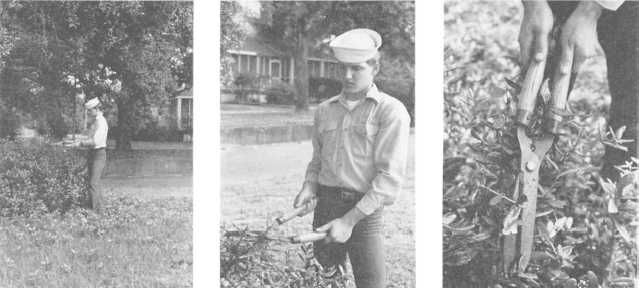302.210
Figure 13-10.–Long shot, medium shot, and closeup shot progression.
simple line drawing examples of TV framing (fig. 13-9)
indicates how to stage and show elements within the
confines of the small 3:4 fixed aspect ratio of a television
picture.
Use high- and low-camera angles with caution.
High angles tend to shorten the legs of a person. Low
angles may distort the body and face of the subject. Of
course, watch for objects that seem to be growing out of
or are balanced on a person's head.
Area of Talent Included
Most motion-media assignments involve people.
You may find it convenient to identify people shots by
the section of the body that is included in the frame. The
person's head is usually in the top of the picture;
therefore, shots vary according to the lowest part of the
talent shown at the bottom of the screen. Thus the terms
used to describe various people shots are as follows: full
figure shot, knee shot, thigh shot, waist shot, bust shot,
head shot, tight head shot.
Number of People Included
The shot designations that are easiest to remember
are the ones that refer to the number of people included
in the picture. When only one person is to be shot, it is
a one-shot. Obviously, a shot that shows two people is
a two-shot, three people make a three-shot, and so on;
however, when five or six people are pictured it is called
a group-shot. A crowd-shot is when a large group of 20
or more people is being framed.
BASIC SEQUENCE
During motion-media recording, you can change
the image size by changing the camera-to-subject
distance or by using a zoom lens (which also changes
the field of view).
When recording an event on motion media, there are
three basic shots or sequences you must use: long shots
(LS), medium shots (MS), and closeup shots (CU)
(fig. 13-10). The type of shot being used can limit or
increase the amount of visual information presented to
the viewer. Long shots generally establish a location. A
medium shot is used primarily as a transition between a
long shot and closeup shot. Closeup shots create impact
and provide more detail and less visual information
pertaining to the subject's surroundings.
Shot classifications can be broken down into five
categories: extreme long shots, long shots, medium
shots, closeup shots, and extreme closeup shots.
Extreme Long Shots
An extreme long shot (ELS) is used to portray a vast
area from an apparently very long distance. An ELS is
used to impress the viewer with the immense scope of
the setting or scene. An ELS is best usually when made
with a stationary camera. Camera panning for an ELS
13-15



